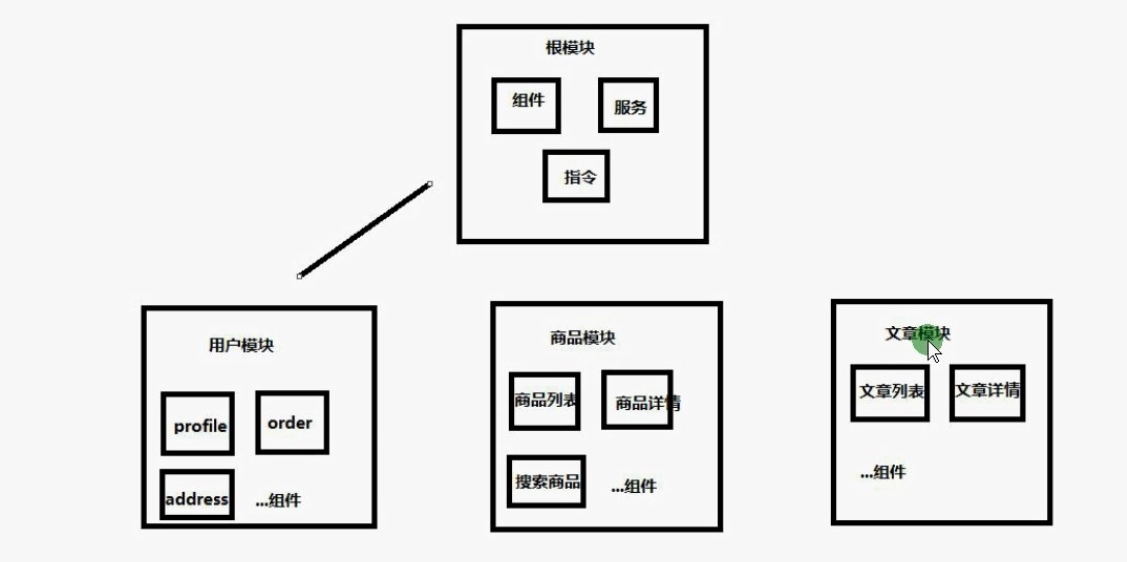实例在angularlazyload:
创建自定义模块,根据需要让根模块与不同的子模块动态的绑定—-懒加载
/*
- 创建带路由的模块:ng g module module/user —routing
- 创建同名组件: ng g component module/user
- 在子模块中配置路径,配置前先import对应组件 ```typescript import { NgModule } from ‘@angular/core’; import { RouterModule, Routes } from ‘@angular/router’;
import { UserComponent } from ‘./user.component’;//引入组件
const routes: Routes = [ {path:’’,component:UserComponent}//配置路径 ];
@NgModule({ imports: [RouterModule.forChild(routes)], exports: [RouterModule] }) export class UserRoutingModule { }
4. 在需要调用的html页面添加routerLink,router-outlet标签:```html<header><a [routerLink]="[ '/user' ]" >user下的用户模块</a><a [routerLink]="[ '/product' ]" >product下的商品模块</a><a [routerLink]="[ '/article' ]" >article下的文章模块</a></header><router-outlet></router-outlet>
- 在根路由中进行配置: ```typescript import { NgModule } from ‘@angular/core’; import { RouterModule, Routes } from ‘@angular/router’;
// const routes: Routes = [ // {//配置根路由,实现路由懒加载,不需要import // path:’user’,loadChildren:’./module/user/user.module#UserModule’ // }, // {//配置根路由,实现路由懒加载,不需要import // path:’article’,loadChildren:’./module/article/article.module#ArticleModule’ // }, // {//配置根路由,实现路由懒加载,不需要import // path:’product’,loadChildren:’./module/product/product.module#ProductModule’ // },
// ];
const routes: Routes = [ {
path:'user',loadChildren:()=>import('./module/user/user.module').then(mod=>mod.UserModule)
}, {
path:'article',loadChildren:()=>import('./module/article/article.module').then(mod=>mod.ArticleModule)
}, {
path:'product',loadChildren:()=>import('./module/product/product.module').then(mod=>mod.ProductModule)
},
{path:’**’,redirectTo:’user’}
];
@NgModule({ imports: [RouterModule.forRoot(routes)], exports: [RouterModule] }) export class AppRoutingModule { }
注意:配置根路由时有些版本不兼容,可能导致Error:Cannot find module,可将:<br />path:'user',loadChildren:'./module/user/user.module#UserModule' 改为:<br />path:'user',loadChildren:()=>import('./module/user/user.module').then(mod=>mod.UserModule) 即可!<br />*//* 显示子模块中的子组件的页面:访问 [http://localhost:4200/user/address](http://localhost:4200/user/address) 时显示address中的内容<br />第一种形式:在上面的基础上,直接在子模块的路由中配置路径,这样配置时直接将子模块(user)中的子组件(ProfileComponent)挂载到根路由(app-routing)上了。```typescriptimport { NgModule } from '@angular/core';import { RouterModule, Routes } from '@angular/router';import { ProfileComponent } from './components/profile/profile.component';import { AddressComponent } from './components/address/address.component';import { UserComponent } from './user.component';//引入组件const routes: Routes = [{ /*这样配置时是在子模块的路由中配置路径时形成父子路由关系,此时子组件是挂载到子路由(user-routing)的,需要在路由中添加:<router-outlet></router-outlet>标签*/path:'',component:UserComponent,children:[{path:'profile',component:ProfileComponent},]},//这样配置时直接将子模块(user)中的子组件(ProfileComponent)挂载到根路由(app-routing)上了。{path:'address',component:AddressComponent}];@NgModule({imports: [RouterModule.forChild(routes)],exports: [RouterModule]})export class UserRoutingModule { }
第二种形式:在上面的基础上,在子模块的路由中配置路径时形成父子路由关系,此时子组件是挂载到子路由(user-routing)的,想要访问http://localhost:4200/user/profile的内容需要在子路由中添加:
import { NgModule } from '@angular/core';import { RouterModule, Routes } from '@angular/router';import { ProfileComponent } from './components/profile/profile.component';import { AddressComponent } from './components/address/address.component';import { UserComponent } from './user.component';//引入组件const routes: Routes = [{ /*这样配置时是在子模块的路由中配置路径时形成父子路由关系,此时子组件是挂载到子路由(user-routing)的,需要在路由中添加:<router-outlet></router-outlet>标签*/path:'',component:UserComponent,children:[{path:'profile',component:ProfileComponent},]},//这样配置时直接将子模块(user)中的子组件(ProfileComponent)挂载到根路由(app-routing)上了。{path:'address',component:AddressComponent}];@NgModule({imports: [RouterModule.forChild(routes)],exports: [RouterModule]})export class UserRoutingModule { }
*/

